Parsley is a widely known herb with many uses, most popularly for garnish. Growing parsley is beneficial because while it’s beautiful to spruce a plate up with, parsley is also delicious and edible in a variety of ways. Learn to grow your own parsley in your herb garden!
If you are planting an herb garden, chives are another wonderful herb to grow!
Contributed by Jodi Torpey, author and Master Gardener.
Parsley is an easily identifiable herb because it’s been used to decorate plates of food for years. But there’s more to parsley than a green garnish. This herb (Petroselinum) adds fresh flavor to many recipes, plus it makes a delicious soup or sauce on its own.
It is a biennial plant, but in many regions it’s planted and grown as an annual. It might surprise you to find out there are more than 30 varieties of parsley. The types gardeners are most familiar with are curly-leaf parsley and Italian flat-leaf parsley, but all varieties have tasty dark-green leaves that are loaded with vitamins and minerals.
Parsley can be grown in the herb garden, vegetable garden (it’s great at repelling some pests as a companion plant!), container garden, and even mixed into flower gardens and rose beds. Curled parsley makes a nice border plant along sidewalks or the edges of the perennial garden, too.
Grow Some Greens!
Ready to grow fresh greens, no matter WHERE you live? Sign up for my
FREE quick-start guide and start growing some of your own food!
New to gardening? Limited on space? The 5-Gallon Garden gives you the skills you need to grow food in the space you have. Get started with your garden today!
Garden varieties of parsley
Plant plenty of parsley – more than you think you’ll need. Parsley is a favorite food of the parsley worm caterpillar, the one that grows into swallowtail butterflies. The parsley worm caterpillar won’t kill the plant, but will enjoy a good deal of leaves.
The most common types of parsley are curled parsley (Petroselium crispum) and flat-leaf or Italian parsley (Petroselium neapolitanum). Two lesser-known parsley types include Hamburg parsley (Petroselium tuberosum) and Japanese parsley (Cryptotaenia japonica).
Moss Curled parsley is the most familiar type of parsley gardeners grow. This parsley is cold hardy and grows to about 10 inches tall and wide. Under the right conditions it can grow and flower the following season.
Single Italian is a flat-leaf parsley that has deeply serrated, dark-green leaves. Chefs often prefer Italian parsley to curly because it offers more depth of flavor. Grows to 12-18 inches tall and 4-6 inches wide.
Hamburg parsley is usually grown for its white parsnip-like roots that are used to make soups or to bake; the leaves are similar to Italian parsley. Grows to about 12 inches tall and 10 inches wide.
Japanese parsley, also called Mitsuba, also looks a bit like Italian parsley, but the leaves are slightly bitter—perfect for some styles of Asian cuisine. Grows to 18-24 inches tall and 8 inches wide.
How to plant and grow parsley
Parsley is slightly frost tolerant so it can be planted in early spring. Parsley can grow from seedlings started indoors, seeds planted in the garden or from transplants purchased at a garden center.
Starting seeds indoors
If you’re starting parsley seeds indoors, plan to get started 6-8 weeks before the average last frost date in your cold-weather area or before you want to move seedlings to the garden. Transplant once the soil and air temperatures have warmed; keep soil moist.
Sowing parsley seeds outside
If you’re direct sowing parsley seeds in your garden, wait until all danger of frost has passed to plant. Have patience because seeds germinate slowly (as long as 5 weeks) and unevenly. To help seeds germinate faster, soak them in lukewarm water overnight before planting.
When planting, cover seeds lightly with about 1/8-inch of soil and keep them moist. Thin when seedlings are 2-3 inches tall with a final spacing of 10-12 inches apart.
Planting garden-ready parsley transplants
Because of the amount of time it takes parsley seeds to germinate, some gardeners opt to buy and plant parsley transplants to help get a faster start. Place transplants plants about 8-12 inches apart to allow for them to grow and spread.
Water transplants and apply a layer of mulch like crushed leaves or dry and untreated grass clippings. Mulch will help keep the soil cool and moist, just make sure to keep mulch away from the crown of the plant.
Requirements for growing parsley
Soil requirements
Parsley needs soil rich in organic matter and to help hold in some moisture. Amend the garden soil with compost dug in deeply before planting seeds or transplants.
Light requirements
Locate parsley in a spot that gets full sun, at least 6-8 hours of sun a day for the healthiest plants. If the sun is too harsh in the height of summer, plants can take a little shade to prevent sun scald.
Fertilizer and water requirements
Unlike some other herbs, parsley needs nitrogen fertilizer to grow its deep green leaves. Fertilize garden plants once or twice during the season with a general-purpose fertilizer.
Water parsley deeply and consistently, at least once a week. Don’t let the soil dry out completely.
Prevent parsley problems
Prevent soil-borne fungal problems, like Alternaria leaf blight, by planting healthy seeds and plants. Rotate parsley planting spots every 2 years.
Keep plants healthy by planting seeds at the recommended depth and no deeper to keep seedling leaves from coming in contact with the soil.
Avoid problems with damping off by planting in well-drained soil. Keep roots healthy by avoiding soggy soil or by planting in raised beds or containers to help with drainage.
Watch for aphids on parsley leaves and stems and wash them off with strong sprays of water. Repeat daily as needed until no aphids remain.
How to plant parsley in containers
Parsley grows well in containers, either planted as one plant or in combination with other herbs. Match the size of the container to the estimated size of the mature herbs. A big enough container allows plants to grow a healthy root system, plus larger pots won’t need watering quite as often as small containers.
Ensure the container has holes in the bottom to help water drain away from roots to keep plants healthy. Cover the drainage holes with paper coffee filters to keep the soil in place.
Fill containers to 2 inches below the rim with a quick-draining potting soil meant for container plantings. To give plants a good start, mix in a granular slow-release fertilizer before planting.
If using transplants, dig a small hole in the soil and place plants at the same depth as they were in their container. Gently firm soil around roots and water slowly at soil level to help plants get settled in.
Fertilize with a water-soluble plant fertilizer every 3-4 weeks through the growing season.
When to harvest parsley
Parsley leaves can be clipped once they are large enough to use in cooking. Use only the freshest bright-green leaves. Clip stems close to the soil level starting with the outside stems. Take a few stems at a time to allow the plant to keep on growing.
Keep clipping leaves to use fresh or to dry and save for later. When harvesting to use fresh, wash and squeeze dry between two paper towels to remove moisture and make it easier to chop for recipes.
How to use parsley in the kitchen
Parsley is good to use fresh at the end of cooking, to toss with green salads, or to add to vegetable dishes. Parsley also mixes into cheese spreads, pasta dishes, potato salads, and omelets.
Dried parsley is best used in foods with longer cooking times, like soups or sauces. Use parsley with other herbs, like chervil, chives, marjoram, and tarragon, to extend its use in the kitchen.
To preserve parsley for future uses, freeze in small plastic containers or hang bunches to dry.
Propagating parsley
Parsley can continue to grow into fall and can take a light frost. Leave garden plants in place to see if they’ll re-sprout and grow next spring. Because of its biennial nature, parsley will grow a flower stalk the second year and produce seeds.
Protect plants for overwintering in cold-weather areas with a light cover of mulch.
Let the flowers dry on the plants and wait for the seeds to dry before collecting them to save and grow in the future.

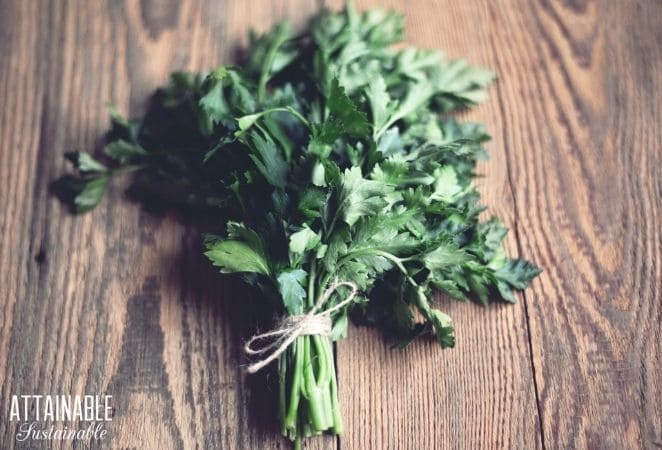

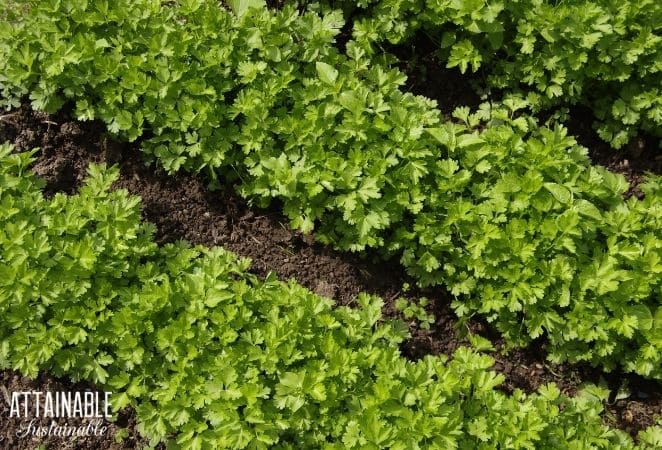
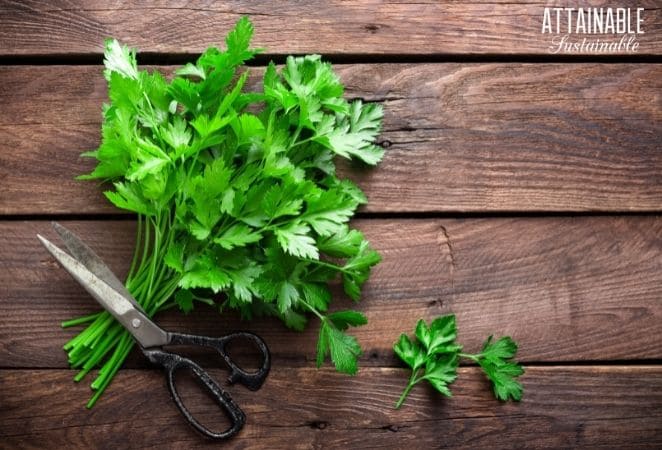
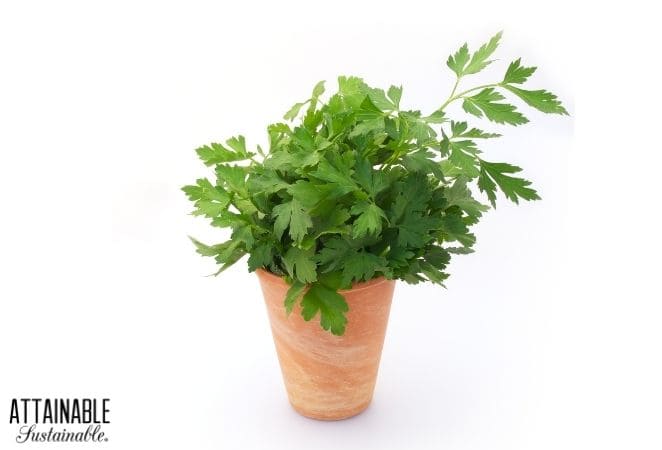
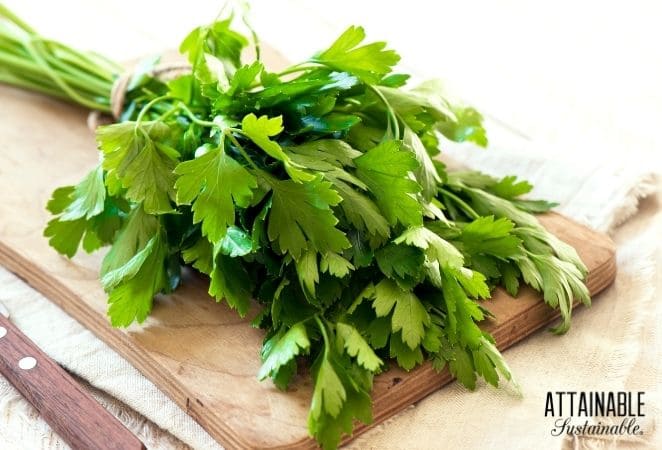
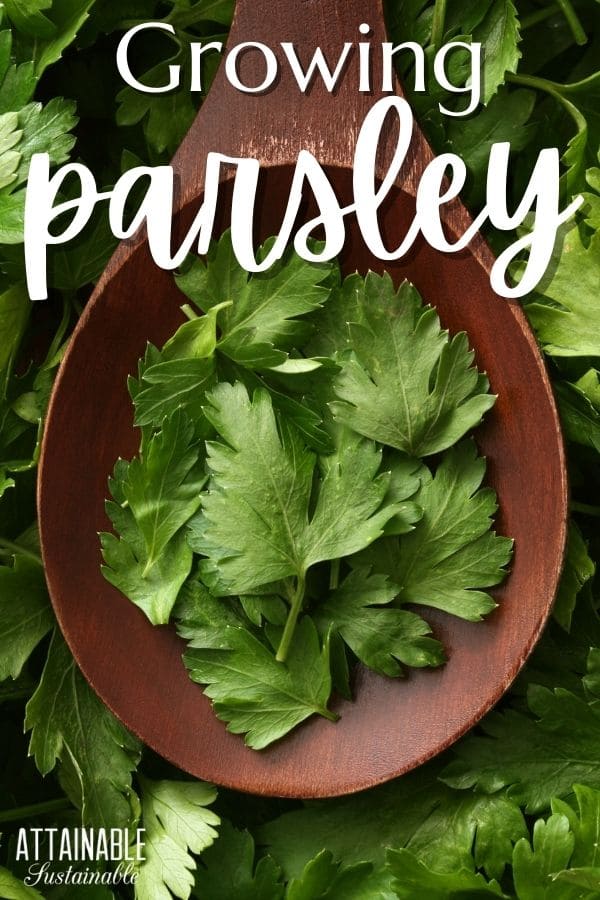





hi, wondering if you have more details on how to grow parsley from seed? does it benefit from stratification? tips on how to keep the growing medium consistently moist for five weeks? is it best to keep the seeds in a cooler growing spot or is ambient temperature of 80 degrees ok? I mean to say, are there special considerations for getting seed to germinate when it’s hot out? I’d like to grwo from seed but parsley hasn’t germinated for me so I’d appreciate some help:) Thank you!
Try starting them indoors, once you transplant them outside using drip irrigation should help with moisture. Good luck!